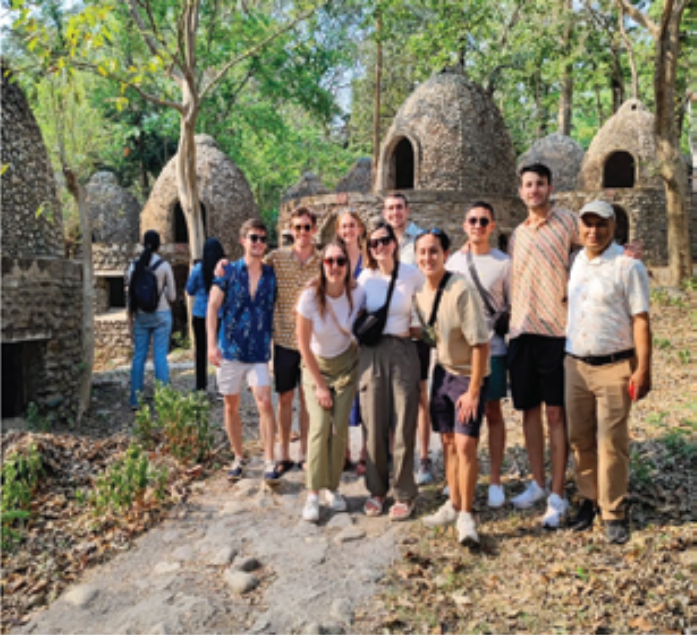“Beatles Ashram buildings are lying in neglect, they should be revived in a phased manner.”
Raju Gusain is the Indian Ambassador of The Beatles Story, the biggest museum of the band located in Liverpool. A freelance journalist, Gusain has seen the Beatles Ashram (also known as Chaurasi Kutiya) in Rishikesh up and close. In a free-wheeling chat with Tuhina Banerjee, he shares his thoughts about the place and the Fab Four.
How did your association with Chaurasi Kutiya (Beatles Ashram) in Rishikesh begin?
I came to Chaurasi Kutiya for the first time in 2003. The intention was to write a report for the Hindustan Times, the newspaper I was working with as correspondent at that time. After 2003, my tour to the Ashram became quite regular as I used to go there to identify old buildings and conduct tours for media friends. I got obsessed with my research on the Beatles stay in Rishikesh. With this, my pursuit to get archival newspaper clippings and photographs of the Liverpool boys in Rishikesh started. I approached various people in Rishikesh but failed to get proper documents. After that I used the internet to establish contact with people who were here in 1968 learning meditation at the Maharishi Mahesh Yogi Ashram. This worked and I now have old newspaper clippings, books on the Beatles staying in India and photographs.
Can you please share some rare or little known things or facts about the place?
Maharishi Mahesh Yogi took this Ashram land on lease from the forest department. The annual lease rent was Rs 150 per year. The 20-year lease ended in 1981 and after that the Maharishi Ashram made many attempts to get the lease renewed. The process involved moving from Rishikesh to Dehradun to Lucknow, but it never got completed. When the lease renewal process was in the final stages, the forest department decided to impose commercial lease rent. Even this took a long time and in the process, the Supreme Court of India passed a judgment on a PIL in 1999 that any person or organisation living inside forest area without a valid lease permission should be removed. After that, the Ashram came under the control of the Rajaji National Park (now known as Rajaji Tiger Reserve).
How was the place when you first visited it and how is it now?
When I came here for the first time in 2003, the building had fresh paint and whitewash. Though the buildings were vandalized but were strong. Now the buildings are crumbling and are lying in a state of complete neglect. I still remember, a jungle developed in the Ashram. It was hard to move inside with dense bushes. It was dangerous to venture inside as wildlife and reptiles were spotted on the campus. I was the happiest person when the Uttarakhand government decided to reopen the Chaurasi Kutiya Ashram for visitors in 2015. The bushes were cleared and the wall repaired to make the place safe for visitors.
You are also the Indian Ambassador of The Beatles Story, the biggest museum of the band located in Liverpool. How do you see your role evolving?
It is a huge honour. Though the position is honorary, it is a great feeling to feature among 26 Ambassadors of the Beatles Story from 21 countries. Presently, an exhibit of the Beatles in India is underway at Liverpool. I conducted a tour of the Beatles Story team, when they were here in 2017. Walking with Diane Glover and Clare Ireland and sharing stories of the Fab Four in the holy township was a memorable outing.
You have been closely associated with the setting up of the gallery housing Beatles band’s photos during their stay in Beatles Ashram. How was the experience like?
That was possible only because many like-minded people with the intention of doing something at the Ashram joined hands. The Maharishi Mahesh Yogi family members and his followers played key roles. We are thankful to famous Canadian filmmaker Paul Saltzman for providing the rare and stunning photographs of the Beatles’ stay in Rishikesh for the photo gallery. The list of names of people who made it happen includes Raja Richard, Tony Ellis, Tim Jones, Anand Shrivastav, Laxman Shrivastav and the then director of Rajaji Tiger Reserve Sanatan Sonker. The photo gallery and Maharishi Knowledge Centre are a major attraction in the Ashram.
How do you see Transcendental Meditation propounded by Maharishi Mahesh Yogi? Why do you think the Beatles got drawn to it?
The Beatles achieved name and fame at an early age. The pressure of being icons on the youths was immense. George Harrison’s wife Pattie Boyd inspired the Beatles to opt for Transcendental Meditation (TM). By practicing TM, all the members of the musical group benefited. TM is still popular worldwide. I would urge the youths to try meditation and witness the magical change in their lives.
The Beatles abandoned western clothes and adopted Indian costumes. They led a simple life in the Ashram by eating vegetarian food and staying away from drugs and liquor. The peaceful location of the spiritual camp inspired them to compose 48 songs. The trip had a big impact in the lives of the Beatles group.
Please tell us about the various murals on the Ashram premises that add to the beauty of the place.
Now, many art lovers tour the Ashram to see the murals. They are at many places. The art captures Rishikesh scene, Beatles, hill life, etc. Legally speaking, making graffiti on the government land is not allowed. With a big number of posts and photographs available on social media, Chaurasi Kutiya now attracts a big number of youth who want to take photographs of the mural paintings. They will just ask the forest staff, “Where is the painting hall?” They head directly to the painting hall and explore other wall paintings in the Ashram, courtesy social media.
How did the visit of Beatles impact the place?
The visit created media hype about Rishikesh worldwide. Earlier, it was used as a camping site by the pilgrims heading for the Char Dham – Badrinath, Kedarnath, Gangotri and Yamunotri — but after 1968, Rishikesh emerged as a top destination for foreign tourists.
Currently, the Beatles Ashram is in ruins. Some say the structures should be revived and repaired while others say it should be left as is. What’s your take?
I think all the infrastructure should be revived in a phased manner. The infrastructure should be used. Or else it will go from bad to worse. We shouldn’t let it languish in ruins. The place should be properly restored and a slice of the glorious past taken care of.

Do you think Chaurasi Kutiya or Beatles Ashram should be turned into an international heritage tourism destination?
Yes, but for this multiple activities should be introduced there. I was at Rajaji Tiger Reserve office a few months back and came to know that the department is planning something big. Let’s hope that happens and everyone is benefited. In the past, they wanted to start a natural trail and bird watching – an ecotourism plan.
If you were given the reins of Chaurasi Kutiya or Beatles Ashram, what would be your plan of action?
A: Ha..Ha (laughs). I don’t think I am the right person to reply to this question. The Rajaji Tiger Reserve is the right authority to answer it. They should have a plan of action.


 The writer is a freelancer who specialises in lifestyle and wellness issues
The writer is a freelancer who specialises in lifestyle and wellness issues